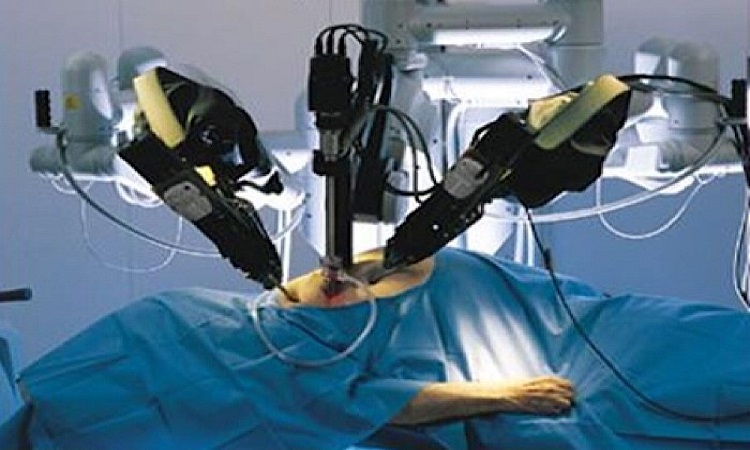The hospitals of La Fe de Valencia and San Juan de Alicante are committed to technology and R&D, with an innovative system for transporting samples and using thousands of data to discover and prevent pathologies
A robotic arm takes a tube with a patient’s sample. Puts it in a smart, self-contained car monitored by GPS. He first takes it to the centrifuge. Then, to the rest of the assigned tests. When he’s finished, he goes to a waiting area. You may be asked for new tests. If this happens, it starts up again. If not, he goes to the storage sector. This process has been carefully designed, and is controlled by the professionals of the clinical analysis service, who at the end will send a report with the results.
Crossing the information from databases, medical records, analysis and medical guides and applying artificial intelligence models and prototypes are built to predict diseases. With these results, the lives of many people are improved and that of many others is saved.
They are not paragraphs taken from the latest science fiction best seller to hit the market. They are two realities that exist here and now. As close as they are in Valencia and Alicante. Specifically, in the clinical analysis laboratories of the La Fe and San Juan hospitals, respectively.
They have a new intelligent robotization system that allows the thousands of tests that are carried out daily to be managed with greater speed and quality. And artificial intelligence solutions have been incorporated into the day to day that add improvements in real time and immediately to patients.
An important achievement has been achieved in both: time. The processes have been automated. All this technology frees doctors from routine tasks to focus their minds on investigating other diseases, working on other projects or improving a diagnosis in areas that are still largely unknown.
Laboratory medicine has resulted in a substantial leap in quality. It has gone from a traditional laboratory model to a leading laboratory model. It is no longer only involved in diagnosis. Now he guides him and stars.
An amazing trip
The more than 3,000 samples that are analyzed daily in the new intelligent robotization system that has been installed in the clinical analysis laboratory of the Hospital Universitario La Fe in Valencia make an amazing journey through a chain of more than 40 meters.
It doesn’t last long. Barely an hour and a half if it is a routine analysis. Little more than 20 minutes if the sample comes from the emergency room. 357 smart cars are capable of moving along this chain at the same time. Each one has a different sample inside.
This new facility “will allow an improvement in the service we provide to the patient, the incorporation of new solutions and diagnostic tools and the optimization of the response,” says Dr. Begoña Laíz, head of the hospital’s clinical analysis laboratory service.
Furthermore, “it has allowed us to unify all the phases of the process, pre-analytical, analytical and post-analytical, and it has also enabled us to include the emergency laboratory. The whole process is now unified, ”she adds.
It has been arranged in the functional areas of biochemistry and immunochemistry. “They are the ones that process the most complex samples, handle a very large number of them and due to their high volume they are difficult to organize”, explains the doctor. Hemostasis and hematology have their own chains.
Begoña Laíz, head of the clinical analysis laboratory service at Hospital La Fe in Valencia.
The advantages do not end there: “The number of samples that we can handle increases, as does their quality; errors are reduced and, as a consequence of this, the safety of professionals is increased by not having to handle samples as was done before, and that of patients. Finally, we must highlight the traceability that we obtain; we know at all times the status of each sample ”, Laíz reels.
The impact of technology is going to be felt in a health area that serves nearly 300,000 people. In it, more than nine million analytical tests are generated per year from hospitalization, external consultations, the emergency service, primary care centers and laboratories of other health departments.
The laboratory has this service and this cutting-edge technology thanks to a public tender through which it has been endowed with a budget of eight million euros for a period of four years.
A detective job
The information contained in a tube with a patient’s sample is pure gold. There it is. There are thousands of data. Some are intuited. Others remain hidden. Discovering one and the other is one of the greatest challenges faced by laboratory medicine and the staff that integrates it.
In this detective work, the physicians of these clinical analysis laboratories currently have a primary help: artificial intelligence (AI). With it, they process and order thousands of patient data. Thanks to this tool and its power, they detect evils and save lives.
“We have a very avant-garde technology that we take advantage of not only to make the diagnosis that the doctor needs, demands or suspects, but also to add other tests according to the characteristics of that patient, by age, symptoms, or what the clinical guidelines say , and benefit him even more ”, says Dr. María Salinas, head of the clinical analysis service at this hospital.
Salinas gives the example of the more than 300 patients detected with hypercalcemia, or high levels of calcium in the blood. A problem that, if not detected early, can weaken the bones or form kidney stones in those who suffer from it. “With our technology we have been able to measure calcium in the blood every three years in patients over 45 years old,” she describes.
Or also with the early detection of diabetes by introducing a simple laboratory test with which glycosylated hemoglobin is measured. It is not done to all patients. Only those over 45 who have a certain level of glucose in the blood. The result has been the location in a few years of thousands of undiagnosed diabetes cases.
“It has nothing to do with detecting diabetes or hypercalcemia early or after years, when some organs are already affected,” she emphasizes. A rigorous control and a change in lifestyle in the first case or a simple operation to remove the paratoid gland in the second can be the solution to both problems. “With a simple and very cheap test, early detection is performed, the patient is protected and there is fantastic prevention of some diseases,” she summarizes.
Advanced solutions
The 240,000 people who live in the area of influence of the Hospital San Juan de Alicante are the main beneficiaries of these support solutions for clinical decision making.
The laboratory of this center processes the tests of more than 1,000 patients per day. Most of them come from primary care, but they also originate in the emergency department, specialist doctors or admitted patients. In this place everything comes together. Here the data, knowledge, guidelines, references present in ordered medical records of the last 15 years and the intentions of the professionals are mixed. Everything is interconnected. With artificial intelligence it is possible to shuffle all this and get a winning hand.
“With the consensus of the primary care doctors and the hospital management, we decided to do a series of tests and discard others that are not necessary. Always with the aim of benefiting a patient in a specific situation ”, details the head of clinical analysis of the center.
In this way, models and prototypes are built to predict diseases. “When a patient goes to the hospital by whatever channel, the possibility of suffering a certain disease is established with a very high precision or percentage,” she says.
Dr. Salinas offers another example to illustrate the above: “With artificial intelligence and the millions of data that we handle at the same time, and at such a high speed, we take advantage of it to create models in order to see if we can detect thyroid diseases in older women 45 years old. They are quite frequent and sometimes undetectable, without acute symptoms, but that disable them for the tasks of daily life
Intelligent solutions like this facilitate the interpretation of the immensity of data that is generated from a patient to support the clinician in their decision-making at all times and in real time.
Smart investment
Treatments, diagnostics and prevention. Laboratory medicine leaves its mark with the use of technology in the entire process that the patient goes through. Taking into account that the stories of thousands of people in these two hospitals pass through his hands, it is the medical specialty that treats the most patients in these centers daily.
Hence the importance that precision models are established with these techniques with a very high percentage of success if a patient has the possibility of suffering from certain syndromes or diseases.
Without losing sight of other benefits that also come into play. Decrease in the percentage of errors, in the variability in the decision of the clinicians and in a greater efficiency of the health system. Because in an increasingly aging society, with more healthcare and economic pressure and with limited resources, doctors can dedicate more time and energy to improving the health of patients. As Dr. María Salinas says, “only with what a reagent strip is worth can we discover a pathology and improve that person’s life.”
The conclusion to her reasoning is also provided by her: “Investing in laboratory medicine with technology and artificial intelligence is currently investing in prevention.”
Ahead opens a world of infinite possibilities. Because you are only at the beginning of this path. To the examples that have already been seen, many others are added: the identification of vitamin B12 deficiency; Models are also being tested in myeloma, a disease whose prognosis is greatly improved if diagnosed early; in thrombosis, in the prediction of the absence of urinary infection, in patients who attend the emergency department or in the detection of magnesium deficiency in those over 65 years of age. “We can’t cope, there are so many possibilities,” exclaims the doctor, who is committed to exporting this model to laboratories in other centers.
And it all starts with a simple gesture. With an analysis that the patient has to be performed for any reason. From there, technology opens the door for the doctor to walk one step ahead. It gives you the option to anticipate what is going to happen. Then he can watch, find out what is going on and act. The medicine of the future is here.
“The laboratory is the great unknown of hospitals,” says Begoña Laíz, from Hospital La Fe. Indeed, many think that the work done in these spaces is limited to receiving the samples, analyzing them and giving the results. Nothing is further from reality. In fact, the laboratory “is responsible for providing 70% of the diagnoses of patients and a large volume of results,” she recalls.
But the silent work of the laboratory begins much earlier. Right at the moment a doctor sends a patient a test. A gear is then set in motion in which not only the result matters. Extraction, transport and conservation are also essential. Before, all this “was done manually, while now it is all very automatic and works with state-of-the-art technology,” explains María Salinas, from Hospital San Juan. Thanks to this, time is saved that specialists in laboratory medicine take advantage of to investigate and improve the health of patients.




